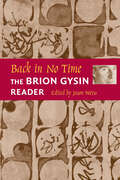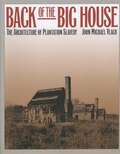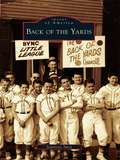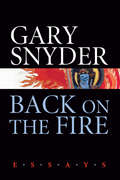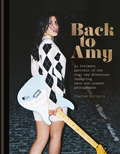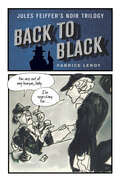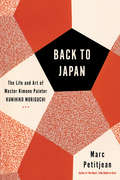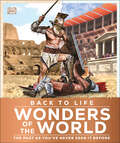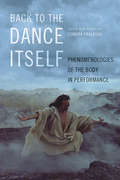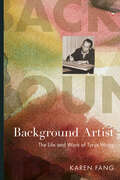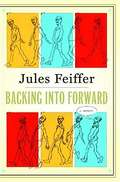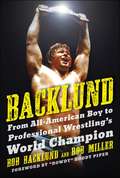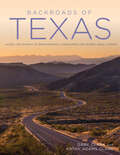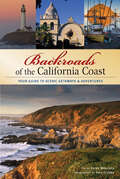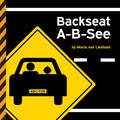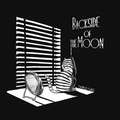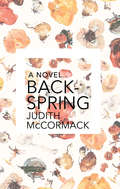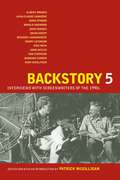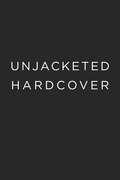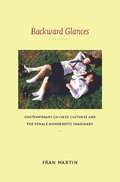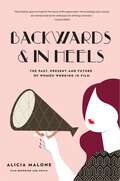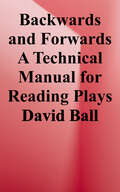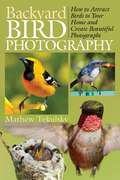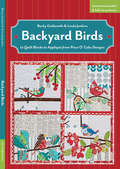- Table View
- List View
Back in No Time: The Brion Gysin Reader
by Brion GysonThe first anthology of writings by the brilliant avant-gardist: &“A valuable book that makes accessible an artist too long considered a cult-eccentric.&” —Publishers Weekly Born in 1916, Brion Gysin was a visual artist, historian, novelist, and experimental poet credited with the discovery of the &“cut-up&” technique—a collage of texts, not pictures—which his longtime collaborator William S. Burroughs put to more extensive use. He is also considered one of the early innovators of sound poetry, which he defined as &“getting poetry back off the page and into performance.&” Back in No Time gathers materials from the entire Gysin oeuvre: scholarly historical study, baroque fiction, permutated and cut-up poetry, unsettling memoir, selections from The Process and The Last Museum, and his unproduced screenplay of Burroughs&’ novel Naked Lunch. In addition, this reader contains complete texts of several Gysin pieces that are difficult to find, including &“Poem of Poems,&” &“The Pipes of Pan,&” and &“A Quick Trip to Alamut.&”
Back of the Big House: The Architecture of Plantation Slavery
by John Michael VlachBehind the "Big Houses" of the antebellum South existed a different world, socially and architecturally, where slaves lived and worked. John Michael Vlach explores the structures and spaces that formed the slaves' environment. Through photographs and the words of former slaves, he portrays the plantation landscape from the slaves' own point of view. The plantation landscape was chiefly the creation of slaveholders, but Vlach argues convincingly that slaves imbued this landscape with their own meanings. Their subtle acts of appropriation constituted one of the more effective strategies of slave resistance and one that provided a locus for the formation of a distinctive African American culture in the South. Vlach has chosen more than 200 photographs and drawings from the Historic American Buildings Survey--an archive that has been mined many times for its images of the planters' residences but rarely for those of slave dwellings. In a dramatic photographic tour, Vlach leads readers through kitchens, smokehouses, dairies, barns and stables, and overseers' houses, finally reaching the slave quarters. To evoke a firsthand sense of what it was like to live and work in these spaces, he includes excerpts from the moving testimonies of former slaves drawn from the Federal Writers' Project collections.
Back of the Yards (Images of America)
by Jeannette SwistThe Back of the Yards neighborhood, located in back of the Union Stockyards and composed of Packingtown, Town of Lake, and New City, was the setting of Upton Sinclair's classic 1906 novel, The Jungle. Permeated by an unforgettable smell, Back of the Yards was a melting pot of immigrants, many who worked in the stockyards. In 1894, Mary McDowell started the University of Chicago Settlement House in Back of the Yards. She improved living conditions and in 1905 helped create Davis Square Park. The Back of the Yards Neighborhood Council was founded in 1939 by Joseph Meegan, Saul Alinsky, and Bishop Bernard Sheil and is America's oldest notforprofit communitybased organization. It consisted of 185 delegate organizations involving residents, business owners, churches, parks, schools, and social clubs that worked to advocate improvements. The council motto continues on as "We the people will work out our own destiny." Relive the bustling activity and the lives of the people in the neighborhood through the historic images in Back of the Yards.
Back on the Fire: Essays
by Gary SnyderThis collection of essays by Gary Snyder, now in paperback, blazes with insight. In his most autobiographical writing to date, Snyder employs fire as a metaphor for the crucial moment when deeply held viewpoints yield to new experiences, and our spirits and minds broaden and mature. Snyder here writes and riffs on a wide range of topics, from our sense of place and a need to review forestry practices, to the writing life and Eastern thought. Surveying the current wisdom that fires are in some cases necessary for ecosystems of the wild, he contemplates the evolution of his view on the practice, while exploring its larger repercussions on our perceptions of nature and the great landscapes of the West. These pieces include recollections of his boyhood, his involvement with the literary community of the Bay Area, his travels to Japan, as well as his thoughts on American culture today. All maintain Snyder's reputation as an intellect to be reckoned with, while often revealing him at his most emotionally vulnerable. The final impression is holistic: We perceive not a collection of essays, but a cohesive presentation of Snyder's life and work expressed in his characteristically straightforward prose.
Back to Amy
by Charles Moriarty'...it's really quite beautiful' Matt Everitt, BBC Radio 6 MusicHappy, beautiful and full of fun - this is an intimate portrait of the real Amy Winehouse.With over 100 photographs - many seen here for the first time - along with personal stories and recollections from Amy's mother, Janis Winehouse, as well as Amy's band members and others close to her, this is a celebration of a young artist on the cusp of fame. Taken by a friend at a relaxed photoshoot just before she released her debut album, these beautiful images give an early glimpse of the girl who would captivate the world.With a foreword by Asif Kapadia, director of Academy Award-winning documentary Amy, and containing fond memories and insights from the people who knew her best, Back to Amy is a tribute to the enduring spirit of a truly special artist.
Back to Basics: A Complete Guide to Traditional Skills (Back to Basics Guides)
by Abigail R. GehringAnyone who wants to learn basic living skills—the kind employed by our forefathers—and adapt them for a better life in the twenty-first century need look no further than this eminently useful, full-color guide. Countless readers have turned to Back to Basics for inspiration and instruction, escaping to an era before power saws and fast food restaurants and rediscovering the pleasures and challenges of a healthier, greener, and more self-sufficient lifestyle. Now newly updated, the hundreds of projects, step-by-step sequences, photographs, charts, and illustrations in Back to Basics will help you dye your own wool with plant pigments, graft trees, raise chickens, craft a hutch table with hand tools, and make treats such as blueberry peach jam and cheddar cheese. The truly ambitious will find instructions on how to build a log cabin or an adobe brick homestead. More than just practical advice, this is also a book for dreamers—even if you live in a city apartment you will find your imagination sparked, and there's no reason why you can't, for example, make a loom and weave a rag rug. Complete with tips for old-fashioned fun (square dancing calls, homemade toys, and kayaking tips), this may be the most thorough book on voluntary simplicity available.
Back to Black: Jules Feiffer’s Noir Trilogy (Critical Graphics)
by Fabrice LeroyThe legendary American cartoonist and author Jules Feiffer has enjoyed a long and varied career, working on everything from illustrating The Phantom Tollbooth to writing the screenplay for the film Popeye. But some of his most innovative work came very late in his career, with a trio of graphic novels he composed in his eighties: Kill My Mother (2014), Cousin Joseph (2016), and The Ghost Script (2018). Back to Black provides the first full-length critical analysis of this trilogy, exploring how it pays homage to the iconography and themes of film noir through constant graphic experimentation and a striking reinvention of Feiffer’s distinctive style. Fabrice Leroy shows how Feiffer deftly alternates between dramatic and satirical tones as he plays with the conventions of noir to provide a caustic yet moving commentary on mid-twentieth-century American life. Through close readings of each novel in the trilogy, he examines Feiffer’s singular depiction of the central political issues in the United States from the Great Depression to the 1950s, which still resonate today: unionization struggles, cinematic propaganda, McCarthyism, the American Dream, immigration, antisemitism, civil rights, and gender discrimination. Placing the noir trilogy into the context of Feiffer’s long career, Back to Black demonstrates how he offers a loving pastiche of the genre without losing his unique voice or critical edge.
Back to Japan: The Life and Art of Master Kimono Painter Kunihiko Moriguchi
by Marc PetitjeanFrom the critically acclaimed author of The Heart: Frida Kahlo in Paris, a fascinating, intimate portrait of one of Japan&’s most influential and respected textile artists. Writer, filmmaker, and photographer Marc Petitjean finds himself in Kyoto one fine morning with his camera, to film a man who will become his friend: Kunihiko Moriguchi, a master kimono painter and Living National Treasure—like his father before him. As a young decorative arts student in the 1960s, Moriguchi rubbed shoulders with the cultural elite of Paris and befriended Balthus, who would profoundly influence his artistic career. Discouraged by Balthus from pursuing design in Europe, he returned to Japan to take up his father&’s vocation. Once back in this world of tradition he had tried to escape, Moriguchi contemporized the craft of Yūzen (resist dyeing) through his innovative use of abstraction in patterns. With a documentarian&’s keen eye, Petitjean retraces Moriguchi&’s remarkable life, from his childhood during the turbulent 1940s and 50s marked by war, to his prime as an artist with works exhibited in the most prestigious museums in the world.
Back to Life Wonders of the World (DK Back to Life History)
by DKFrom sunset at Stonehenge to the steps of the Forbidden City, see the wonders of the world and the people who built and used them brought back to life in stunning detail.Discover humanity's greatest monuments restored to their former glory in this guide to the wonders of the world. Incredible History: Wonders of the World turns back time to reveal realistic reconstructions of the most incredible monuments humankind has ever constructed.Imagine if you could travel back in time and visit the wonders of the world. Where would you go first? You&’ll feel the roar of the crowd in the Roman Colosseum, observe an eclipse at Chichen Itza and stride along the walls of Great Zimbabwe. Children aged 9+ will learn when and how it was constructed, and what it teaches us about how the people who lived at the site might have spent their days. Each story begins by showing you the wonder as it is today and you can marvel at the location recreated in jaw-dropping 3D detail.This fascinating guide to the wonders of the world contains: - Information that goes beyond the curriculum to give a truly international view of the past, from the Palace of Versailles in France to the largest Buddhist temple in the world: Borobudur, Indonesia.- Pages packed with fascinating facts, data, and detail. - The wonders of the world are restored to their former glory with 3D computer artworks, going into incredible detail and depth.- Story boxes that put the discovery in context and go behind the scenes showing how archaeologists unearth the past.With each page packed with fantastic facts and extraordinary pictures, Incredible History: Wonders of the World brings together the best bits of history and archaeology to recreate our wondrous past. Combining archaeological evidence and computer technology, the book brings the people and places of the past back to life before your very eyes.
Back to the Dance Itself: Phenomenologies of the Body in Performance
by Sondra FraleighIn Back to the Dance Itself, Sondra Fraleigh edits essays that illuminate how scholars apply a range of phenomenologies to explore questions of dance and the world; performing life and language; body and place; and self-knowing in performance. Some authors delve into theoretical perspectives, while others relate personal experiences and reflections that reveal fascinating insights arising from practice. Collectively, authors give particular consideration to the interactive lifeworld of making and doing that motivates performance. Their texts and photographs study body and the environing world through points of convergence, as correlates in elemental and constant interchange modeled vividly in dance. Selected essays on eco-phenomenology and feminism extend this view to the importance of connections with, and caring for, all life. Contributors: Karen Barbour, Christine Bellerose, Robert Bingham, Kara Bond, Hillel Braude, Sondra Fraleigh, Kimerer LaMothe, Joanna McNamara, Vida Midgelow, Ami Shulman, and Amanda Williamson.
Background Artist: The Life and Work of Tyrus Wong
by Karen FangYou might not know the name Tyrus Wong, but you probably know some of the images he created, including scenes from the beloved Disney classic Bambi. Yet when he came to this country as a child, Tyrus was an illegal immigrant locked up in an offshore detention center. How did he go on to a long and prosperous career drawing animation cels, storyboards, and greeting cards that shaped the American imagination? Background Artist shares the inspiring story of Tyrus Wong’s remarkable 106-year life and showcases his wide array of creative work, from the paintings and fine art prints he made working for Roosevelt’s Works Progress Administration to the unique handmade kites he designed and flew on the Santa Monica beach. It tells how he came to the United States as a ten-year-old boy in 1920, at a time when the Chinese Exclusion Act barred him from legal citizenship. Yet it also shows how Wong found American communities that welcomed him and nurtured his artistic talent. Covering everything from his work as a studio sketch artist for Warner Bros. to the best-selling Christmas cards he designed for Hallmark and other greeting card companies, this book celebrates a multitalented Asian American artist and pioneer.
Backing into Forward: A Memoir
by Jules FeifferA gifted storyteller who has delighted readers and theater audiences for decades, Jules Feiffer now turns his talents to the tale of his own life. Plagued by learning problems, a controlling mother, and a debilitating sense of fear, Feiffer embarked on his first cartoon apprenticeship at the age of seventeen, emboldened only by a passion for success and an aptitude for failure. He vividly recalls those transformative years working under the legendary Will Eisner, and later, after he was drafted into the army, his evolution from "smart-ass kid into an enraged satirist." Backing into Forward also traces Feiffer's love life, from a doomed hitchhiking trip to reclaim his high-school sweetheart to losing his virginity in Greenwich Village, and his road to marriage and fatherhood. At the center of this journey is Feiffer's prolific creativity. In dazzling detail, he recounts the birth of his subversive graphic novella Munro, his entrée into New York's literary salons, collaborations with film greats Mike Nichols, Robert Altman, and Jack Nicholson, and other major turning points. Brimming with wry punch lines, slices of Americana, and pithy social commentary, Backing into Forward charts Feiffer's rise as an unlikely and incisive provocateur during the conformist fifties and the Vietnam and Civil Rights sixties and seventies.
Backlund: From All-American Boy to Professional Wrestling's World Champion
by Robert H. Miller Bob Backlund Roddy PiperBob Backlund began life as a poor farm boy in the little village of Princeton, Minnesota, with a population of just over 2,000 people. He was a below-average student with a lackluster work ethic and a bad attitude, who hung with the wrong crowd and made a lot of bad choices. He was a kid whose life was headed for disaster-until a local coach took interest in him, suggested that he take up amateur wrestling, and offered to work with him if he promised to stay out of trouble.It was in North Dakota that Bob Backlund had the first of several chance encounters that would shape his destiny. While working out at the YMCA gymnasium in Fargo, North Dakota, where he wrestled for North Dakota State, Backlund met a well-known professional wrestler, "Superstar” Billy Graham. The men talked, and at Graham’s suggestion, Backlund was inspired to pursue a career in professional wrestling.Less than five years from that day, on February 20, 1978, Backlund would find himself halfway across the country, standing in the middle of the ring at Madison Square Garden with his hand raised in victory as the newly crowned World Wide Wrestling Federation Heavyweight Champion. The man Backlund pinned for the championship that night was none other than "Superstar" Billy Graham.Featuring contributions from Bruno Sammartino, Harley Race, Terry Funk, Pat Patterson, Ken Patera, Sergeant Slaughter, The Magnificent Muraco, George "The Animal” Steele, "Mr. USA” Tony Atlas, The Iron Sheik, and many others, this book tells the incredible story of the life and nearly forty-year career of one of the most famous men to ever grace the squared circle.Skyhorse Publishing, as well as our Sports Publishing imprint, is proud to publish a broad range of books for readers interested in sports-books about baseball, pro football, college football, pro and college basketball, hockey, or soccer, we have a book about your sport or your team.In addition to books on popular team sports, we also publish books for a wide variety of athletes and sports enthusiasts, including books on running, cycling, horseback riding, swimming, tennis, martial arts, golf, camping, hiking, aviation, boating, and so much more. While not every title we publish becomes a New York Times bestseller or a national bestseller, we are committed to publishing books on subjects that are sometimes overlooked by other publishers and to authors whose work might not otherwise find a home.
Backroads of Texas: Along the Byways to Breathtaking Landscapes & Quirky Small Towns
by Gary Clark Kathy Adams ClarkDiscover the strange, sublime, and breathtaking sights of Texas with this illustrated guide featuring thirty backroad excursions.The second largest state in America, Texas is home to a vast array of hidden treasures waiting just off the beaten path. Backroads of Texas guides readers to intriguing sites, offbeat characters, and glorious landscapes that are typically missed by interstate travelers.Watch frenzied bats as they fly by the thousands from San Angelo’s Foster Road Bridge. Catch your breath as you drink in the majestic Guadalupe Mountains. Get ready for goosebumps when you spelunk into the shadowy depths of Inner Space Cavern. And try not to get spooked when you see the paranormal “ghost lights” near the eclectic town of Marfa. These off-road sights are what truly set the Lone Star State apart from its neighbors.Completely reimagined for a new generation of road-trip takers and explorers, Backroads of Texas is lavishly illustrated with photographs, maps, and vintage advertising of Texas’s many scenic, historic, and cultural attractions.
Backroads of the California Coast: Your Guide to Scenic Getaways & Adventures
by Karen MisuracaA guide to exploring the natural beauty and historic sites of the Pacific coast via a selection of lesser-known scenic routes throughout California.From sprawling beaches to dramatic cliffs, the landscapes carved out by the mighty Pacific Ocean have been a destination for adventure and discovery since the earliest Spanish explorers arrived in the 1600s. While here and there the coastal wilderness has given way to California’s largest and most cosmopolitan cities, the backroads and mountain lanes afford countless opportunities to experience the quiet of nature or explore the history of centuries-old communities. Visit sleepy fishing villages and historic landmarks of the Old West; hike through lush wilderness and fish in clear mountain streams; or catch some waves at one of the many pristine beaches along California’s glorious coastline.With glorious color photography and detailed descriptions, maps, and directions, Backroads of the California Coast offers two dozen fascinating and scenic journeys through some of the nation’s most glorious landscapes.
Backseat A-B-See
by Maria van Lieshout“Just when you thought there couldn’t possibly be another idea for an alphabet book—buckle up for this one! . . . Clever [and] fun.” —Kirkus Reviews (starred review).Vroom! Vroom! Whether on a cross-country road trip or a quick jaunt across town, there’s no end to what a child can see from the backseat of a car. Using familiar road signs, this striking book introduces little ones not just to the alphabet but also to the world around them.Equally perfect for transportation-obsessed children and those just learning to read, this fresh and dynamic picture book will entertain and educate at home, in the classroom, and on the go.“Backseat drivers will enjoy learning the language of the road along with their ABCs.” —Publishers Weekly“The alphabet. In road signs. Genius.” —Wired
Backside of the Moon: Keeping Your Zen, One Smile At A Time
by Tango GaoThe first book by Shanghai-born visual artist, cartoonist, social media phenomenon, and advertising executive Tango to be published in the United States, MADITATION is a brilliantly tongue-in-cheek dissection of the everyday insanities of 21st-century urban living--and a witty guide to how to keep one's calm in the midst of the craziness. Tango's doodles have a simple, fluent, and funny style. His humor is obvious without words and explanation. Everything he draws has its own expression. Even air has a shape and a piece of bread can be a protagonist. Tango celebrates finding joy and surprise in our daily life. No matter how small we are and how frustrating life can be, we shall endeavor to feel “alive." Tango's playful line drawings may just help you attain inner peace and tranquility--but at the very least they will make you smile.
Backspring
by Judith Mccormack"A joy to read. "—Nino Ricci "A wonderfully and uniquely gifted storyteller. "—Midwest Book Review Eduardo, an architect from Lisbon, has come to Montreal to be with his wife Geneviève. Geneviève researches fungi and likes to catalog her orgasms. But when Eduardo is caught in an explosion and rumors of arson begin to circulate, both his marriage and his fledgling architecture firm verge on collapse. Gorgeous, colorful, and richly described, Backspring is a sensual taxonomy of desire. Judith McCormack, born near Chicago, has been nominated for the Commonwealth Writers Prize and the Rogers Writers' Trust Fiction Award.
Backstory 5: Interviews with Screenwriters of the 1990s
by Patrick McGilliganPatrick McGilligan continues his celebrated interviews with exceptional screenwriters in Backstory 5, focusing on the 1990s. The thirteen featured writers—Albert Brooks, Jean-Claude Carrière, Nora Ephron, Ronald Harwood, John Hughes, David Koepp, Richard LaGravenese, Barry Levinson, Eric Roth, John Sayles, Tom Stoppard, Barbara Turner, and Rudy Wurlitzer—are not confined to the 1990s, but their engrossing, detailed, and richly personal stories create, in McGilligan’s words, "a snapshot of a profession in motion." Emphasizing the craft of writing and the process of collaboration, this new volume looks at how Hollywood is changing to meet new economic and creative challenges. Backstory 5 explores how these writers come up with their ideas, how they go about adapting a stage play or work of fiction, how they organize and structure their work, and much more.
Backstory 5: Interviews with Screenwriters of the 1990s
by Patrick McgilliganPatrick McGilligan continues his celebrated interviews with exceptional screenwriters with Backstory 5, focusing on the 1990s. The thirteen featured writers are not confined to the 1990s, but their engrossing, detailed, and richly personal stories create, in Patrick's words, "a snapshot of a profession in motion."
Backward Glances: Contemporary Chinese Cultures and the Female Homoerotic Imaginary
by Fran MartinBackward Glances reveals that the passionate love one woman feels for another occupies a position of unsuspected centrality in contemporary Chinese mass cultures. By examining representations of erotic and romantic love between women in popular films, elite and pulp fiction, and television dramas, Fran Martin shows how youthful same-sex love is often framed as a universal, even ennobling, feminine experience. She argues that a temporal logic dominates depictions of female homoeroticism, and she traces that logic across texts produced and consumed in mainland China, Hong Kong, and Taiwan during the twentieth century and the early twenty-first. Attentive to both transnational cultural flows and local particularities, Martin shows how loving relations between women in mass culture are usually represented as past experiences. Adult protagonists revel in the repeated, mournful narration of their memories. Yet these portrayals do not simply or finally consign the same-sex loving woman to the past--they also cause her to reappear ceaselessly in the present. As Martin explains, memorial schoolgirl love stories are popular throughout contemporary Chinese cultures. The same-sex attracted young woman appears in both openly homophobic and proudly queer-affirmative narratives, as well as in stories whose ideological valence is less immediately clear. Martin demonstrates that the stories, television programs, and films she analyzes are not idiosyncratic depictions of marginal figures, but manifestations of a broader, mainstream cultural preoccupation. Her investigation of representations of same-sex love between women sheds new light on contemporary Chinese understandings of sex, love, gender, marriage, and the cultural ordering of human life.
Backwards & In Heels: The Past, Present and Future of Women Working in Film
by Alicia MaloneStories of women in the film industry, onscreen and off, and interviews with Ava DuVernay, America Ferrera, Geena Davis, Octavia Spencer, and more. Ginger Rogers did everything that Fred Astaire did. She just did it backwards and in high heels . . . One of the first people to ever pick up a motion picture camera was a woman—as was the first screenwriter to win two Academy Awards, the inventor of the boom microphone, and the first person to be credited with the title Film Editor. From Hollywood&’s earliest days, women have been revolutionizing, innovating, and shaping how we make movies. Yet their stories are rarely shared. In Backwards and in Heels, film reporter and author of The Female Gaze Alicia Malone tells the history of women in film through stories about incredible ladies who made their mark throughout each era of Hollywood, from the first women directors, to the iconic movie stars, to present-day activists. These inspiring stories also highlight the specific obstacles women have had to face. Backwards and in Heels combines research and exclusive interviews with influential women and men working in Hollywood today, such as Geena Davis, J.J. Abrams, Ava DuVernay, Octavia Spencer, America Ferrera, Paul Feig, Todd Fisher, and many more, as well as film professors, historians, and experts.
Backwards and Forwards: A Technical Manual for Reading Plays
by David BallConsidered an essential text since its publication thirty-five years ago, this guide for students and practitioners of both theater and literature complements, rather than contradicts or repeats, traditional methods of literary analysis of scripts. <p><p>The author developed his method during his work as literary director at the Guthrie Theater, building his guide on the crafts playwrights of every period and style use to make their plays stage-worthy. The text is full of tools for students and practitioners to use as they investigate plot, character, theme, exposition, imagery, conflict, theatricality, and the other crucial parts of the superstructure of a play. <p><p>Also included are guides for discovering what the playwright considers a play' s most important elements, thus permitting interpretation based on the foundation of the play rather than its details. Using Shakespeare's Hamlet as illustration, the author assures a familiar base for clarifying script-reading techniques as well as exemplifying the kinds of misinterpretation readers can fall prey to by ignoring the craft of the playwright. Of immense utility to those who want to put plays on the stage (actors, directors, designers, production specialists) Backwards & Forwards is also a fine playwriting manual because the structures it describes are the primary tools of the playwright.
Backyard Bird Photography: How to Attract Birds to Your Home and Create Beautiful Photographs
by Mathew TekulskyFans of bird watching will rejoice with Backyard Bird Photography, a guide for learning how to set up your backyard in order to take the best photographs of your local birds. In addition to guiding you through the first steps of setting up your plantings and bird feeders, this book describes the types of photographic equipment you will need to get just the right image; how to maneuver yourself into just the right position to create a quality bird photograph; how to compose your shots for the greatest visual effect; and how to use more advanced techniques such as macro lenses and external flash techniques.Author and bird photographer Mathew Tekulsky breaks down the challenges of photographing these beautiful creatures and explains how utilizing your own natural surroundings can create stunning shots that rival those shot in the wild. Tekulsky explains that when your garden is set up as a tiny oasis for these feathered friends--with the right foliage, water sources, and feeders--then your backyard will be frequented by a variety of species on any given day. With tips for gaining the bird's trust and composition, every photograph will come out a stunner.
Backyard Birds: 12 Quilt Blocks to Appliqué from Piece O'Cake Designs
by Becky Goldsmith Linda JenkinsThe bestselling design team guides you in stitching up a flock of cheery appliqué birds.Appliqué lovers, you’ll want to make all 12 of these endearing blocks featuring robins, cardinals, orioles, and other feathered friends from the back yard. Designed in the lively Piece O’ Cake style by Linda Jenkins and Becky Goldsmith, these blocks are bursting with fresh colors and are easy enough to be fun for stitchers of all levels. Pattern pack includes a 16-page instruction booklet and full-size patterns for 12 blocks, plus appliqué borders, that make a 52” x 65” quilt and instructions for a 4 block 39'' x 39'' quilt. Or mix and match your favorite blocks to perk up quilts, pillows, tote bags, or apparel.
